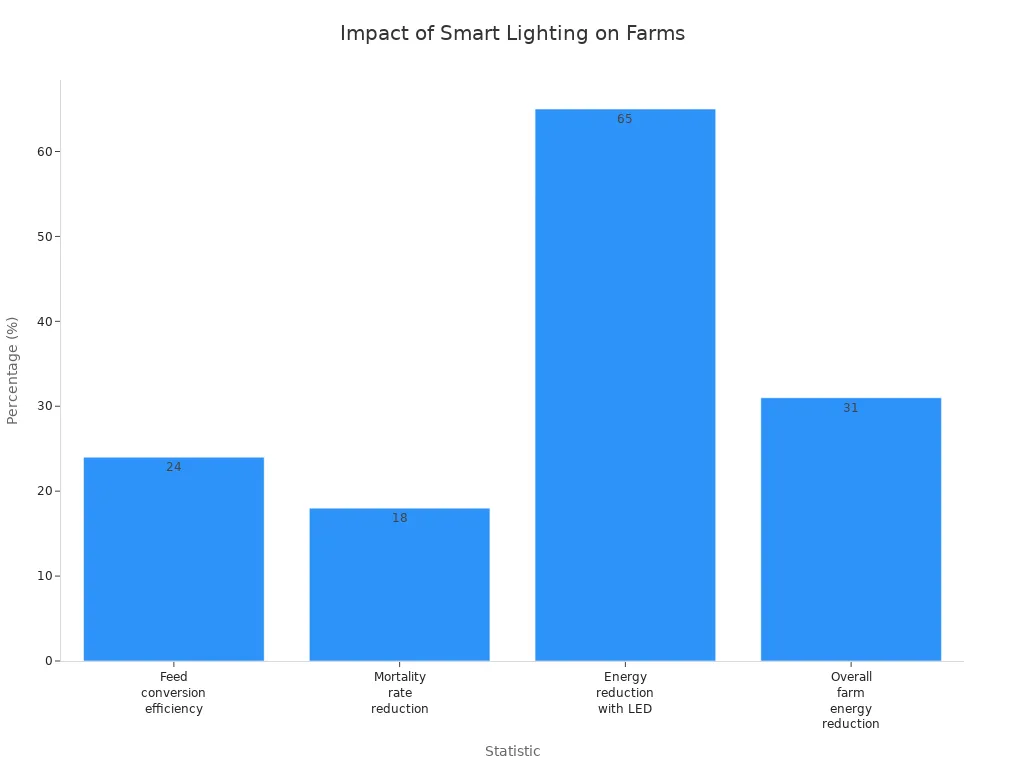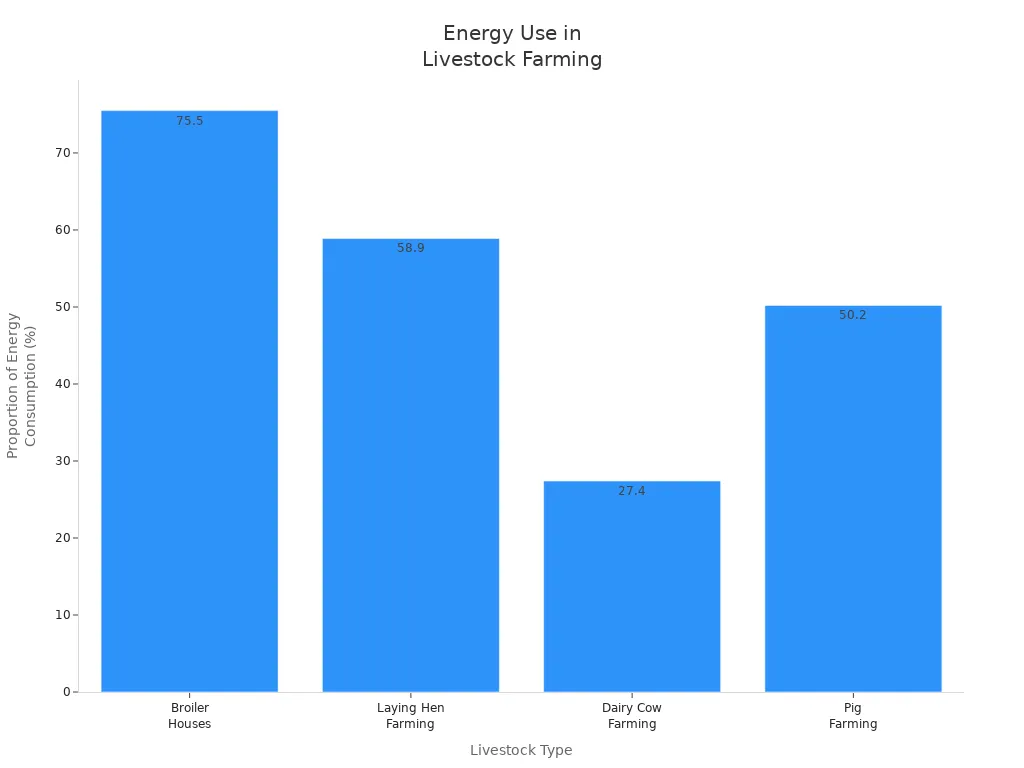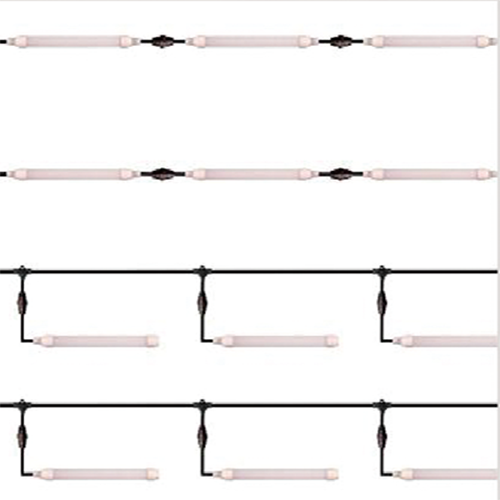
Smart livestock lighting control systems can change how you run big farms. You can save energy and get more production with new technology. Studies show LED lighting uses 65% less energy on average. It also cuts total farm energy use by 31%. The right lighting helps animals eat better by 24%. It also lowers death rates by 18%.
| Statistic Description | Value |
|---|---|
| Improvement in feed conversion efficiency | 24% |
| Reduction in mortality rates | 18% |
| Average energy consumption reduction with LED lights | 65% |
| Overall farm energy consumption reduction | 31% |
| Cost-share payments for energy-efficient installations | $127 million |

You also get more production. For example, better lighting can give a 10% boost in milk output. It can also make growth cycles 12% shorter. Companies like Sanshun lead this change with smart livestock lighting. Their skills in smart technology and teamwork are a great advantage.
Livestock Lighting: Key to Health, Growth & Profit
- Smart livestock lighting can cut energy costs by 65%. This helps you save money as time goes on.
- The right lighting schedules can make animals healthier. Animals eat better and use food more efficiently. This can increase feed efficiency by 24%. It can also lower death rates by 18%.
- LED lights make your farm brighter. They last longer than other lights. This means you spend less time and money fixing them.
- Automated lighting systems fit what animals need. This helps animals grow faster. It can also boost production, like 10% more milk.
- Check and change your lighting settings often. This keeps the best conditions for your animals. It helps them stay healthy and work better.
Smart Livestock Lighting Benefits
Energy Savings
Smart livestock lighting can change how your farm uses energy. These systems use LED lights that need less electricity and produce less heat than old bulbs. You pay less for power, and your animals stay comfortable. If you use modern agriculture LED lights, you spend less money and need fewer lights for the same brightness.
- Smart livestock lighting lets you control energy use with preset lighting for cleaning, milking, or resting.
- Good lighting helps cows follow their natural sleep cycles. This makes animals happier and healthier.
- Farms with smart livestock lighting use less energy and work better.
When you switch to energy-efficient lighting, you notice a big difference. LED lights use less power and last longer, so you save money over time. Smart livestock lighting helps your animals and saves you money.
Sanshun is a leader in smart livestock lighting. Their technology helps you save the most energy. Sanshun’s systems fit easily into your farm and work well.
Productivity Gains
Smart livestock lighting does more than save energy. It helps your farm work better. When you set up lighting schedules, animals grow faster and eat better.
- Continuous lighting can make animals eat less and grow more slowly. Using a 4L:2D cycle helps animals gain more weight without wasting food.
- Cows need dark times. Longer light periods help young cows grow up faster and stay healthy.
- The right light helps animals do better, have more babies, and stay healthy.
- Broilers grow and eat better with special lighting schedules. Longer light helps them grow and eat more.
- A 16L:8D light cycle makes cows give more milk. Young animals grow better with more daylight.
Smart livestock lighting makes animals feel comfortable. Animals get sick less and work better when you control their sleep cycles and copy natural daylight.
Sanshun’s smart livestock lighting is special. Their systems help you get more work done and keep animals healthy. With Sanshun’s technology, you can control how bright the lights are and when they turn on, so your farm makes more money and stays strong.
Livestock Lighting Energy Use
Main Energy Sources
You run many systems in a livestock building. The main energy uses are heating, cooling, ventilation, and agricultural shed lighting. Each animal type needs different things. Environmental control uses a lot of your energy budget. The table below shows how much energy goes to environmental control for each animal:
| Livestock Type | Proportion of Energy Consumption from Environmental Control |
|---|---|
| Broiler Houses | 75.5% |
| Laying Hen Farming | 58.9% |
| Dairy Cow Farming | 27.4% |
| Pig Farming | 50.2% |

Agricultural shed lighting is important for environmental control. You use lights to help animals stay active and healthy. The right lighting makes animals more productive. Good lighting choices save resources and lower your costs.
Lighting’s Role in Costs
Lighting can be a big part of your farm’s energy bill. Old bulbs waste energy and break often. Smart LED systems for agricultural shed lighting fix this problem. You get brighter lights and better control. The lights last longer, too. This helps you use resources better and spend less on repairs.
- LED lights can lower energy costs by up to 65%.
- They give animals brighter and steadier light.
- LED lights last longer than old bulbs, so you replace them less.
- You spend less time and money fixing lights, so you can care for animals more.
Smart agricultural shed lighting helps you use resources better. You can set the lights to match daylight. This helps animals grow faster and stay healthy. Advanced lighting supports better growth, more babies, and healthier animals. Your farm becomes more sustainable and makes more money.
Tip: Smart agricultural shed lighting helps you save money and reach your goals. Your animals do better, and your farm runs smoother.
How Smart Lighting Works
Key Features
Smart lighting control systems use new technology to help farms work better. You use sensor networks, data platforms, and automation to control the lights. These tools work together to watch and change lighting in farrowing rooms, breeding barns, and other animal areas.
| Technology Type | Description |
|---|---|
| Sensor Networks | IoT arrays collect real-time data like temperature and humidity. |
| Data Management Platforms | Cloud systems handle data streams for better decisions. |
| Automation Systems | Smart equipment uses sensor data to change lighting by itself. |
You get energy-efficient LEDs and led lighting for agriculture. These lights use less power and last longer. The systems help you keep the right light for animal health and production. Controlled environment agriculture needs these features to keep animals happy and working well.
Automation and Control
Automation makes lighting for livestock smarter and more useful. You use timers and motion sensors so lights turn on only when needed. This saves energy and helps animals feel better. Good lighting design matches the circadian needs of animals. This lowers stress and helps animals act healthy.
- You keep a steady light for poultry, even in short winter days.
- You help chicks and brooders grow when there is not much sunlight.
- You support health and production for all animals all year.
You work with skilled companies like Sanshun to pick the best system for your farm. Sanshun’s Smart Display Innovation mixes display and lighting technology. This gives you better control over LED lighting for agriculture. You look at what your farm needs and use lighting control systems to help science and make work easier.
Tip: Automated lighting in farrowing rooms and breeding barns saves energy and helps animals. Smart controls make a healthier and more productive place for your animals.
Implementation Steps
Assess and Plan
First, you check your lighting system. You look at lamps, wires, and controls in every barn. You see if the lights are bright enough for animals and workers. Use special tools to measure how bright and even the light is. Find places that are too dark or have old lights. Think about what animals need, what jobs people do, and how the barn is set up. The table below lists steps for checking your lighting:
| Step | Description |
|---|---|
| 1 | Check how good your lights are now. |
| 2 | Find spots that need better lighting. |
| 3 | Figure out what animals and workers need. |
| 4 | Think about animal types, jobs, and barn layout. |
| 5 | Use tools to measure light and how it spreads. |
When you plan, pick systems that can grow with your farm. Make sure they follow the rules and laws. Choose a new technology that saves money over time. Don’t forget to check for rule changes or hidden costs. Buy things that help your farm reach its goals. Sanshun’s Smart Display Innovation gives you strong controls and good supply chains. This makes it easy to improve your lighting.
Optimize Schedules
Set up lighting schedules that match animal habits. Smart controls let you change the light for feeding, resting, and cleaning. Use sensor data to change brightness and timing. This helps animals stay healthy and work better. For example, a poultry barn with LED lights saw better growth and clearer vision. A dairy farm with smart lighting saved 60% on energy and got more milk.
Tip: Automated schedules help you spend less on labor and give animals steady care.
Monitor and Adjust
Watch your lighting all the time. Sensors check light, animal movement, and the barn’s air. Change settings to help animals do well and stay healthy. Real-time checks help broiler chickens grow faster and have better babies. Automation lowers stress and helps stop sickness. Look at your data often and make changes when needed. Sanshun’s systems let you adjust controls for the best results.
Note: Always watching and changing your lighting keeps animals healthy and helps your farm do better.
Challenges and Solutions
Common Issues
When you use smart livestock lighting, you can face problems. These problems can make your daily work harder. They can also affect how animals feel and live. The table below shows the main problems you might see:
| Challenge | Description |
|---|---|
| Technical Failures | Power cuts, software bugs, or hardware breakdowns can disrupt your lighting system and farm routines. |
| Impact on Animal Welfare | Malfunctions may risk animal safety, especially in automated barns. |
| Harsh Environmental Conditions | Dust, ammonia, and moisture can damage equipment and block sensors. |
| Lack of Backup Plans | Without backup plans, system failures can lead to animal neglect. |
| Dependence on External Help | You may need specialists to fix issues, which can delay urgent care. |
You should think about battery life for smart devices. If batteries die, your devices stop sending data. It is important to keep your farm data safe and private. Pick lighting that has safety certifications to protect everyone.
Tip: Always check if your lighting system is strong. Make sure you have a backup plan for emergencies.
Best Practices
You can solve these problems by using good habits. Start by picking tough lighting that lasts a long time. These lights can work for up to 50,000 hours. This means you do not have to change them often. Use LED fixtures that can handle dust and water.
| Best Practice | Description |
|---|---|
| Switching and Controls | Adjust light intensity, color, and timing to match animal needs for better productivity. |
| Durability and Maintenance | Pick easy-to-maintain fixtures to cut down on waste and repairs. |
| Heavy-duty Lighting | Use systems designed for harsh farm environments to ensure long-term reliability. |
- Control how much light goes into your barns.
- Change the light colors to help animals act better.
- Copy day and night cycles to help animals grow.
Smart lighting with IoT helps you set schedules and use real-time data. Good partners like Sanshun give you support and new technology. This makes your system work better and last longer.
Note: Working with trusted partners helps you get support and new ideas for long-term success.
Smart livestock lighting control systems help farms use less energy. They also help animals stay healthy and work better. Farms can grow more crops and keep animals strong all year. These systems make it easier and safer to run big farms. Many farms now use AI-driven lighting and IoT sensors. This helps farming be better for the future. You can follow easy steps to make your lighting better. Support programs can help you, too. Pick advanced solutions like Sanshun to keep your farm working well and making more.
FAQ
What are the main benefits of using agricultural LED lights in livestock farming?
You pay less for energy and animals stay healthier. Agriculture LED lights help you control the light for your animals. You make poultry and cattle work better. You also help farms last longer. This technology makes your farm run smoothly.
How does smart lighting technology improve sustainability in agriculture?
You use less energy with agricultural LED lights. You make less waste and lower pollution. Smart lighting helps you control animal spaces. You help farms last longer. You also make animals feel better in poultry and cattle barns.
Can agricultural LED lights help with poultry and cattle productivity?
Yes. You help poultry and cattle grow faster. Agriculture LED lights let you control light cycles better. You help animals eat more and grow bigger. You also get more eggs and milk. This technology helps farms work well.
Why should you choose advanced lighting technology for livestock farming?
You control lighting for animals more exactly. Advanced technology lets you change the light for poultry and cattle. You help animals feel better and stay healthy. You also save money on energy bills. This technology helps farms last longer and do better.
How do you start using smart agriculture LED lights in your farming operation?
You check your lights now. You plan to make lighting better for animals. You put in agricultural LED lights with smart controls. You watch how things go in poultry and cattle barns. You change settings to get the best results. This technology helps you reach your farm goals.



